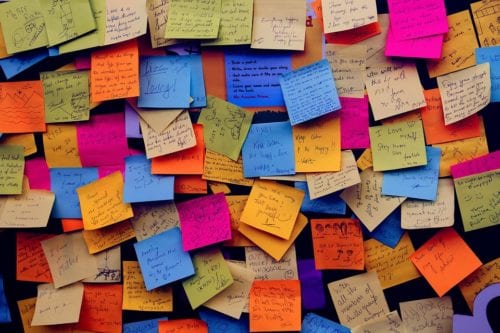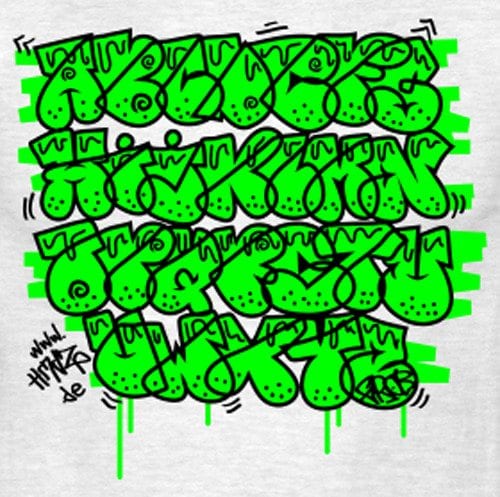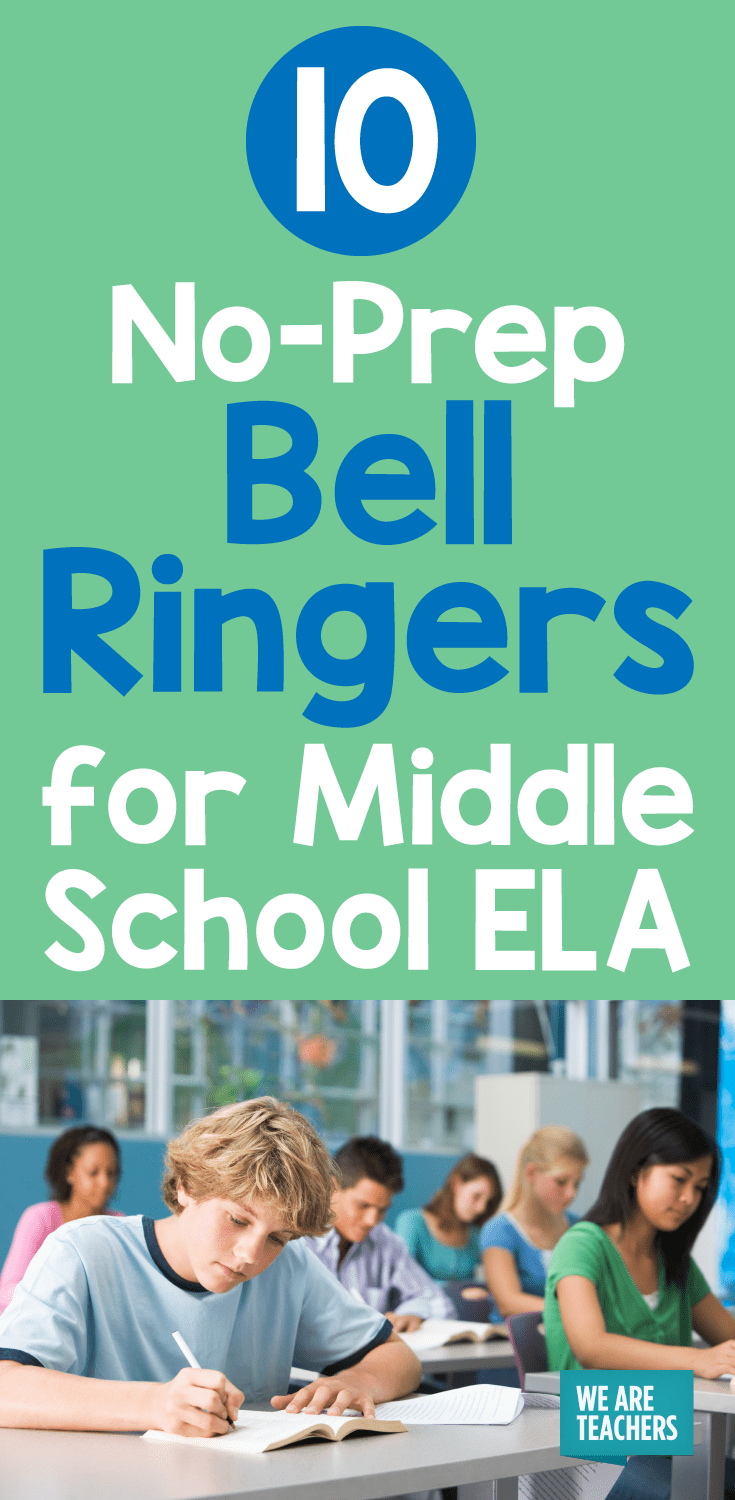Daily Language Arts Warm Ups 7th Grade Bell Ringers Ela
Bell ringers are 1 of those instruction strategies that can truly alter the tone of your class from the second students walk in the door. They create routine, set clear expectations, and get students plugged in and focused during the outset minutes of your lesson. Hither are ten easy-to-implement bell ringers for middle school ELA that require footling prep and work with any text:
1. Name Information technology
Provide students with a curt text and delete the headline. Give students three minutes to read the text and come up with their ain title. Once students have created titles, have them share and, equally a class, choose the favorite.
Skills skillful: Identifying central idea. When students create headlines, talk over what makes a skilful title and how each championship reflects a central idea. Not only does this help students polish the skill of identifying primal ideas, it also helps them to recognize the importance of titles.
2. All-time Evidence
Cutting an opinion slice, editorial, or persuasive piece into 2 or three judgement strips. State a related merits and display at the front of your classroom. Give each student a judgement strip. In groups or rows, ask students to stand in order of all-time to worst evidence to support the claim. Once students are standing in order, inquire them to share their prove from all-time to worst and explain their thinking.
Skills practiced: Citing the best testify to back up a claim. This bell ringer will aid students to be more discerning when choosing evidence to support their arguments. It too provides a dandy starting point to discuss the relevance and strength of testify provided in published piece of work.

3. Figurative Language Hunt
Provide students with an excerpt from a literary text or with pasty notes and then they can mark their novels. Write the following prompt on the board: Mark and label as many types of figurative language (metaphors, similes, imagery, etc.) as you can in iii minutes. After three minutes, instruct students to share their finds with a partner, and then take a whole course give-and-take sharing examples and identifying them.
Skills practiced: Identifying figurative language in a text. Request students to find examples of figurative linguistic communication in context is an authentic learning experience that is more effective than teaching figurative linguistic communication in isolation.
4. Figurative Language Sort
Ahead of time, label four sheets of poster paper: simile, metaphor, personification, and imagery. Provide students with an excerpt from a literary text or tell them to use their reading books. Give each student a sticky note and instruct them to write an example of figurative language from the text onto the sticky note. Next, instruct them to post their gummy note on the corresponding poster. Once students have posted, manus posters to four separate groups of students (one group would become the simile poster, ane the metaphor affiche, etc.). Ask students to examine the sticky notes on their poster and determine if they were accordingly placed. If a gluey note is non in the right identify, tell students to move it to the correct affiche. When students accept finished examining their sticky notes, discuss examples as a class.
Skills practiced: Identifying figurative language in a text and analyzing literature. This bellringer gives students buying of their learning. Non but are they the ones doing the work or identifying figurative language, they are as well doing the piece of work of analyzing responses and determining their accurateness. This helps to solidify their skills, tapping into higher level thinking.
5. Theme in Verse
Print or display a short poem (I like to utilize poetryfoundation.org to detect short, relevant, loftier-interest poetry). Mail the following prompt: Identify the theme of this poem. Employ at least ii details from the verse form to support your response.
Skills expert: Identifying theme and citing text based evidence to support an analysis of the text. I'm a huge believer in sprinkling poetry throughout the school year and not just instruction a single poetry unit. Bell ringers are a not bad place to add together poetry. Poems are brusque and sweet and provide opportunities to fine-tune standards-based skills quickly.

6. Context Inkling Detectives
Give students a paragraph with challenging, related-to-your-content vocabulary (this could be a paragraph from a text you're already reading). Ask students to use context clues to determine the significant of an identified-by-you lot or challenging-to-them word (i.e., you can choose the discussion ahead of fourth dimension OR you can have students choose a challenging term). Tell students to write the definition of the word based on context clues and use 2 details from the text to support their response.
Skills practiced: Using context clues to unpack the meaning of unknown words. Practicing this skill with texts students are already reading with the support of class review and give-and-take will assist students to develop the power to apply context clues more independently afterwards.
7. First or Third
Requite students an extract of any literary text or ask students to use their reading books for this bellringer. Mail service the job: Read through your text and place the indicate of view as commencement or third person. Circle (or mark with a viscous note) the clues that allowed you to identify the point of view. Choice: brand this bell ringer active by request students to stand on i side of the classroom if their novel is in get-go person and on the other side of the classroom if their novel is written in third person.
Skills practiced: Determining the bespeak of view of a text. This is a bell ringer that would exist fun to utilize several days in a row with different texts from dissimilar points of view. Information technology tin be expanded to included all-seeing and limited points of view besides.

8. Fact Shaping
Requite all students a unmarried fact and ask them to do an argument quick write based on that single fact. Subsequently three to five minutes, inquire students to share their writing with a partner and discuss how each pupil shaped their arguments differently. Share every bit a whole class and hash out the ways students used the same fact in different ways.
Skills skillful: Analyzing how authors (the students) writing about the same topic shape their arguments in different ways. This is a dandy fashion to give students perspective and bound start explorations well-nigh the ways different published authors employ facts to shape their arguments.
9. Statement Analysis
Give students a paragraph from an editorial. Ask students to read the editorial as they enter form and stand on 1 side of the room if they believe the author'southward reasoning was relevant and potent and on the other side of the room if they think the writer's reasoning was not stiff. Tell students they must exist prepared to share their reasoning with the form backed up with text based show.
Skills practiced: Trace and evaluate an argument, determining if the reasoning is sound and the evidence is relevant and sufficient. This is a neat warm-up because it gets kids physically moving and thinking through their analysis.

10. Transition Give-and-take Graffiti
Ahead of time, mail a big piece of chart newspaper in your classroom and label it, "Transition Word Graffiti." Give students in your classroom markers and several unlike texts (or ask them to utilise their reading novels). Students search the text for their favorite transition discussion and add together it to the graffiti wall.
Skills practiced: Identifying transition words in published writing volition provide students with a model of means to create cohesion and clarify relationships among their own ideas in writing. The all-time thing most this bong ringer is that information technology provides students with a visual reminder or a wide range of transition words that can remain hanging in your classroom all year long.
Bell ringers provide students with a warm-up to learning. I employ text-based bellringers from a journal I created for my students every day. Students come into my form knowing the expectation is to jump into learning independently.
How exercise you use bell ringers for middle school? I'd dearest to hear!

Source: https://www.weareteachers.com/bell-ringers-for-middle-school/


Komentar
Posting Komentar